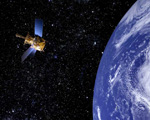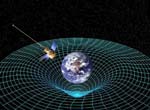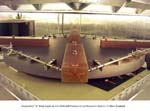WEEKLY HIGHLIGHTS FOR 7 JANUARY 2005:
GRAVITY PROBE B MISSION UPDATE

Throughout the holiday season, the GP-B spacecraft has remained in excellent health, with all subsystems performing well and no anomalous events. The GP-B spacecraft has now completed more than 3,870 orbits over 8.5 months (262 days), and on average, the four gyros have each made approximately one billion revolutions.
The spacecraft's full-sun season has ended, and it is now experiencing longer periods of being eclipsed from sunlight by the Earth during each orbit. It is flying drag-free around gyro #3, maintaining a constant roll rate of 0.7742 rpm (77.5 seconds per revolution.) All four gyros are digitally suspended in science mode. The temperature inside the Dewar is holding steady at 1.82 kelvin, and it is now less than half full of superfluid helium. We have been collecting science data for 19 weeks, and we are now approximately 45% of the way through the science phase of the mission. The data collection process is continuing to proceed smoothly, and the quality of the data remains excellent.
GP-B's MISSION LIFETIME
 Some readers have inquired how it is that we could have expended over half the helium in the Dewar and still be less than half way through the science phase of the mission. The answer is that the Dewar initially contained enough helium to last for the entire mission--approximately 16 months--which includes 4 months of Initialization and Orbit Checkout (IOC), 10 months of science data collection, and 1-2 months of instrument re-calibration. At the point last month when the Dewar reached the half-full level, we had approximately 8 months of helium remaining--enough for 6 more months of science and 2 months of re-calibration--which is what we need.
Some readers have inquired how it is that we could have expended over half the helium in the Dewar and still be less than half way through the science phase of the mission. The answer is that the Dewar initially contained enough helium to last for the entire mission--approximately 16 months--which includes 4 months of Initialization and Orbit Checkout (IOC), 10 months of science data collection, and 1-2 months of instrument re-calibration. At the point last month when the Dewar reached the half-full level, we had approximately 8 months of helium remaining--enough for 6 more months of science and 2 months of re-calibration--which is what we need.
GP-B AND THE DECEMBER 26th INDONESSIAN EARTHQUAKE/TSUNAMI
Over the past three weeks, we have received numerous inquiries regarding any possible relationship between GP-B's experimental measurements and the disastrous earthquake and ensuing tsunami in South Asia on December 26th. The short answer is that this event had no effect on the GP-B experimental data, nor did our gyroscopes detect it. For readers who are interested, more detailed information follows.Richard Gross, a scientist at NASA's Jet Propulsion Lab (JPL) in Pasadena, California, has modeled the coseismic effect on the Earth's rotation of the December 26 earthquake in Indonesia by using the PREM model for the elastic properties of the Earth and the Harvard centroid-moment tensor solution for the source properties of the earthquake. The result of this modeling is:
Change in length of day: -2.676 microseconds (about one second in a millennium)
X-axis polar motion excitation: -0.670 milliarcseconds (approximately 2 centimeters or 0.8 inches)
Y-axis polar motion excitation: +0.475 milliarcseconds (approximately 1.5 centimeters or 0.6 inches)
Since the length of the day can only be measured to an accuracy of about 20 microseconds (20 millionths of a second), this model predicts that the change in the length-of-day caused by the earthquake is too small to be observed. And, since the location of the earthquake was near the equator, this model predicts that the change in polar motion excitation is also rather small, being about 0.82 milliarcsecond in amplitude. Such a small change in polar motion excitation will also be difficult to detect.
Nevertheless, at a science conference in Utah last week, Professor Ulrich Schreiber of the Munich Technical University in Germany reported that his Earth-based, ultra-precise "G" ring laser gyroscope was able to detect perturbations in the Earth's axis as a result of the Indonesian earthquake. This gyroscope--the largest of its kind in the world--contains a giant glass ceramic disc, 4.25 meters in diameter, 25 centimeters thick and weighing 10 tons. It is located in a sealed and pressurized chamber, eight meters below the surface of the Earth, at the Wettzell Fundamental Research Station in New Zealand. This instrument was specifically designed to be able to detect changes in the Earth's rotation within a day. For more information on the "G" ring laser gyroscope, see a 1996 article on the Web site of the International Society for Optical Engineering (SPIE) or download a PDF copy of a 2003 paper from the Wettzell Fundamental Research Station. 
In contrast, the GP-B gyroscopes have not detected any measurable effect as a result of the Indonesian earthquake and tsunami. GP-B is measuring the curvature and twisting of space-time around the Earth, not the planet itself. Our spacecraft is in a circular orbit, 640 kilometers (400 miles) above the earth, always passing over the north and south poles, but varying in its longitudinal path with each orbit. The extremely small change in the earth's polar motion resulting from the Indonesian earthquake/tsunami is simply not significant enough to appear in our measurements. Also, any small change in the Earth’s polar motion will factor itself out, given the changing longitude of each orbit.
Our measurements do depend on knowing our spacecraft’s position relative to specific locations on Earth to a high precision, and for these measurements, we use the Global Positioning System (GPS). It is possible, though highly unlikely, that if a re-calibration in the GPS satellites is required, we may need to incorporate some compensating factors.
Gravity Probe B could conceivably register a change in Earth’s polar orbit, if the change were of immense proportions. For example, suppose the earth's spin axis were to change position by 3 degrees. This would significantly affect local space-time, and this change would be detectable by the science instruments on-board the spacecraft. However, such a change would require a cataclysmic event, ten million times larger than the Indonesian earthquake and tsunami—an event that would mean the end of Planet Earth, as we know it.
The United States Geological Survey (USGS) maintains a Web page of Frequently Asked Questions (FAQ) about the December 26th earthquake and tsunami.
All of us on the Gravity Probe B team are deeply saddened by human tragedy that has emerged in the wake of the tsunami. The importance of the relief efforts cannot be overstated.
NEW PHOTO OF GP-B IN ORBIT FROM AMATEUR ASTRONOMER STEFANO SPOSETTI

Just before the holidays, Swiss amateur astronomer and physics teacher, Stefano Sposetti sent us two new photos of the GP-B spacecraft in orbit, one of which is shown to the right. In this photo, taken on 6 December 2004 (during the spacecraft’s full-sun season), Mr. Sposetti used a 20mm f2.8 photo lens, coupled with a CCD camera on a fixed tripod, with a 60-second exposure to capture a beautiful time exposure of the GP-B spacecraft, rising over a rooftop. You can view other astronomical photos taken by Mr. Sposetti, including photos of the GP-B spacecraft on Mr. Sposetti’s Web page in the Astronomical Image Data Archive (AIDA). As always, we are most grateful to Mr. Sposetti for sending us this extraordinary photo.
THE EINSTEIN EXHIBITION AT THE SKIRBALL CULTRAL CENTER IN LOS ANGELES
 If you're going to be in Los Angeles anytime before 30 May 2005, and if you’re interested in Einstein’s life and work, the Einstein Exhibition at the Skirball Cultural Center (just north of the Getty Museum on Interstate 405) is the most comprehensive presentation ever mounted on the life and theories of Albert Einstein (1879-1955). It explores his legacy not only as a scientific genius who re-configured our concepts of space and time, but also as a complex man engaged in the social and political issues of his era. It examines the phenomenon of his fame and his enduring status as a global icon whose likeness has become virtually synonymous with genius.
If you're going to be in Los Angeles anytime before 30 May 2005, and if you’re interested in Einstein’s life and work, the Einstein Exhibition at the Skirball Cultural Center (just north of the Getty Museum on Interstate 405) is the most comprehensive presentation ever mounted on the life and theories of Albert Einstein (1879-1955). It explores his legacy not only as a scientific genius who re-configured our concepts of space and time, but also as a complex man engaged in the social and political issues of his era. It examines the phenomenon of his fame and his enduring status as a global icon whose likeness has become virtually synonymous with genius.
In this exhibit, you can examine Einstein's report card, inspect his FBI file, and enjoy his family photographs, love letters, and diary entries. Exhibition highlights include scientific manuscripts and original correspondence—including original handwritten pages from the 1912 manuscripts of the special theory of relativity and his 1939 letter to President Roosevelt about nuclear power—and a wealth of other documents from the Albert Einstein Archives at the Hebrew University of Jerusalem.



In addition to these displays of Einstein memorabilia, the exhibit also features a number of interactive components that help provide an understanding of Einstein's revolutionary theories. Furthermore, several “explainers,” identified by their red aprons, are on hand to discuss various aspects of the exhibit and to explain and demonstrate difficult concepts, such as time dilation and warped spacetime. At the end of the exhibit, you’ll find one of GP-B’s gyro rotors on display.
The Einstein exhibition was jointly organized by the American Museum of Natural History (AMNH), the Hebrew University of Jerusalem, and the Skirball Cultural Center. It was designed by the AMNH under the supervision of Dr. Michael Shara, curator of the exhibit and chairman of the museum’s Astrophysics Department. It opened in November 2002 at the AMNH in New York and then traveled to Chicago and Boston, spending about 8 months in each location. It will remain at its final U.S. stop at the Skirball Center in Los Angeles through 29 May 2005, after which time it will move permanently to the Hebrew University in Jerusalem.
Information about the Einstein exhibition is available on the Skirball Center Web site. If you can’t make it to Los Angeles, you can visit the AMNH’s virtual Einstein exhibit on the Web.
Photos and Drawing: GP-B Public Affiars Coordinator, Bob Kahn, created the composite photo of the GP-B spacecraft in orbit and the drawing of the spacecraft in Earth's gravity well using a scale model of the spacecraft, a NASA photo of the Earth, and Adobe Photoshop, The photo of the Dewar is courtesy of Lockheed Martin Corporation. The photos of the "G" Ring Laser Gyroscope were excerpted from a document published by the International Union of Geodesy and Geophysics (IUGG). The photos from the Einstein Exhibit are courtesy of the Skirball Cultural Center. Click on the thumbnails to view these images at full size.
Please Note: Until further notice, we intend to continue posting these GP-B highlights on a weekly basis. Also, from time to time, we may post special reports and special updates, as warranted by mission events.
More links on recent topics
- Track the satellite in the sky
- Photo, video & and news links
- Build a paper model of the GP-B Spacecraft
- Following the mission online
- Our mailing list - receive the weekly highlights via email
- The GP-B Launch Companion in Adobe Acrobat PDF format. Please note: this file is 1.6 MB, so it may take awhile to download if you have a slow Internet connection.
Previous Highlight
Index of Highlights


